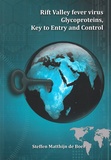Rift Valley fever virus glycoproteins
Key for entry and control

Boer, Matthijn de
- Promoter:
- Prof.dr. R.J.M. (Rob) Moormann
- Co-promoter:
- Dr.ir. B.J. (Berend Jan) Bosch & dr. J.A. (Jeroen) Kortekaas
- Research group:
- Bosch
- Date:
- March 14, 2013
- Time:
- 12:45 h
Summary
In this thesis we have focussed on the RVFV Gn and Gc glycoproteins, the keys for virus entry and virus control. RVFV is an emerging virus that has already spread across the African continent and to the Arabian Peninsula. Outbreaks of RVFV are characterized by abortion storms and high mortality, particularly among young animals. Humans can be infected by exposure to blood or other body fluids of viremic animals or via mosquito bite. RVFV has the potency to spread across large distances by as yet unknown mechanisms, explaining the need for contingency plans in currently unaffected areas. We aimed to develop control measures to protect livestock against RVFV infection. Antibodies directed against the Gn and Gc glycoproteins of RVFV are able to neutralize the virus, which is the only established correlate of protection against RVFV infection. We have developed and characterized different Gn/Gc-based vaccines that are considered safe for animals of all ages and evaluated their efficacy in mouse and sheep animal models. Registration trials with one of our vaccines are currently being performed. We have also investigated the RVFV cell entry mechanism and paid specific attention to the membrane fusion process. We demonstrate that the glycosaminoglycan heparan sulfate is required for efficient RVFV infection of different mammalian cells. Our studies have also confirmed the hypothesis that RVFV membrane fusion occurs in endosomes and is triggered by low pH. The activating pH and the kinetics of virus entry suggest that RVFV penetrates from late endosomal compartments. We further demonstrate that exposure of virus particles to low pH results in the formation of highly stable multimers of the RVFV Gc glycoprotein. Mutagenesis of Gc in combination with biochemical and functional analyses suggest that protonation of specific histidines in Gc plays a crucial role in the conformational rearrangements of the Gc fusion protein that lead to virus entry.